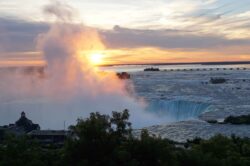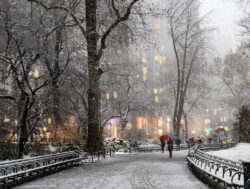Beginners: Watercolor Pigments

 With the wide range of watercolors available, it is important to know the different formulations to create a palette that best suits your needs.
With the wide range of watercolors available, it is important to know the different formulations to create a palette that best suits your needs.
| Each side of the table above lists 4 common transparent and opaque pigments. |
by Naomi Ekperigin
Watercolor paints are those that use water-soluble, complex carbohydrates as a binder. Made of organic and inorganic pigments, today’s watercolor paints use a binder of natural gum arabic, with glycerin and/or honey as additives to improve plasticity and dissolvability of the binder, and with other chemicals added to improve the shelf-life of the paint. Gum arabic is transparent and this is what gives watercolors their brilliancy, but not all paints have the same level of transparency. For example, the quinacridone pigments (oranges and reds) and the phthalocyanine pigments (greens and blues) are very transparent, while cadmiums and iron oxides are more opaque. It is important to know these differences when mixing colors.
Transparent Versus Opaque Pigments
Manufacturers generally label paints as transparent or opaque. When a transparent paint is applied to paper, much of the reflective white surface shows through. One method of testing your colors for transparency or opacity is to paint a strip of waterproof black ink down the paper. When it's dry paint each of your colors in separate bands across it. Let them dry then inspect each color for transparency and degrees of opacity. Top manufacturers are now supplying this sort of information in their color catalogues, along with permanency ratings and whether the color stains.
Beginners are often advised to begin with a palette of transparent colors before venturing into the opaques, because mixing opaques can result in muddy colors. However, some artists recommend having a few opaque earth tones on the palette. “I sometimes play translucent and lighter colors against the more opaque colors,” says artist-instructor Peggy Dressel. “For example, I can make the water in a landscape painting glow more if I play it against rocks and trees painted with more opaque paints.” It is also important to note that there are few completely opaque watercolors, with the exception of gouache. Gouache is made by mixing the standard watercolor with various amounts of an opacifying agent such as chalk. Watercolor paints do not form a cohesive layer on the surface; instead, they scatter pigment particles across the paper surface. Gouache, on the other hand, has a definite thickness and creates a paint layer. Because of its thickness, the effects of gouache paints do not depend on the color of the ground on which they are applied. Transparent watercolors require a highly reflective pure-white ground, which helps create a sense of luminosity; with gouache, the light-reflecting quality comes from the use of white pigments.
It is important to know the properties of each color so that color mixing is most effective. “When mixing a transparent pigment with an opaque or semi-opaque pigment, it’s important to keep the two well mixed,” advises watercolorist Lori Simons. “If the puddle of paint sits undisturbed, the larger particles sink to the bottom while the transparent small particles sit on top of the puddle, causing the mixture to separate.”
Staining and Granulating Pigments
The staining quality of a paint refers to the ease with which a paint can be rewetted once dry and then lifted or blotted off the surface. A staining paint is difficult to remove and less staining colors can be lightened or removed almost entirely when wet, or when rewetted and then lifted by stroking gently with a clean, wet brush and then blotted up with a paper towel. In fact, the staining characteristics of a paint depend in large part on the composition of the surface and on the particle size of the pigment. “Sap green and alizarin crimson are hard to lift because the particles are ground so finely,” notes Simons. “What I like about them is that they let the white of the paper shine through.” Staining is increased if the paint manufacturer uses a dispersant to reduce the time it takes to mix the paint, because the dispersant acts to drive pigment particles into crevices in the paper pulp, dulling the finished color.
Granulation refers to the effect given by some pigments when granules of pigment settle into the indentations of the paper, producing a “grainy” look. Some pigments notable for their watercolor granulation include viridian, cerulean blue, cobalt violet and some iron oxide pigments. Granulating colors also allow for the creation of textural washes, and show up best on rough papers. One can buy watercolor granulation mediums to create the effect in other pigments.
Naomi Ekperigin is the editorial assistant for American Artist.
 Artists Network Membership - 1 Year
Artists Network Membership - 1 Year  Breakthrough Paint Along: Where Mixed Media Combine Together
Breakthrough Paint Along: Where Mixed Media Combine Together  Paint Along 127: Paint the Motion of the Sea
Paint Along 127: Paint the Motion of the Sea  Breakthrough Paint Along: The Big Value of Miniature Landscapes
Breakthrough Paint Along: The Big Value of Miniature Landscapes  Portrait Painting: Rembrandt's Techniques Video Download
Portrait Painting: Rembrandt's Techniques Video Download  Figure Drawing Tips with Brent Eviston Video Download
Figure Drawing Tips with Brent Eviston Video Download  Southwest Art August/September 2025 Digital Edition
Southwest Art August/September 2025 Digital Edition  Artists Magazine July/August 2025 Digital Edition
Artists Magazine July/August 2025 Digital Edition  Pastel Journal Summer 2025 Digital Edition
Pastel Journal Summer 2025 Digital Edition  Artists Magazine March/April 2025 Digital Edition
Artists Magazine March/April 2025 Digital Edition  Artists Magazine January/February 2025 Digital Edition
Artists Magazine January/February 2025 Digital Edition  Best of Watercolor: Winners of the Splash 26 Competition Print Edition
Best of Watercolor: Winners of the Splash 26 Competition Print Edition  Southwest Art June/July 2025 Print Edition
Southwest Art June/July 2025 Print Edition  Artists Magazine May/June 2025 Print Edition
Artists Magazine May/June 2025 Print Edition  Southwest Art 2021 Digital Collection × 1
Southwest Art 2021 Digital Collection × 1  Watercolor Artist 2020 Digital Collection × 1
Watercolor Artist 2020 Digital Collection × 1  Watercolor Artist 2019 Annual Digital Collection × 1
Watercolor Artist 2019 Annual Digital Collection × 1  Watercolor Mega Magazine Collection × 1
Watercolor Mega Magazine Collection × 1  Pastel for Beginners Workshop
Pastel for Beginners Workshop  Composition & Design for Landscape Painting Video Workbook
Composition & Design for Landscape Painting Video Workbook  Drawing Mastery: Shading Course
Drawing Mastery: Shading Course  Alla Prima Bootcamp: 4 Weeks to Confident Painting Course
Alla Prima Bootcamp: 4 Weeks to Confident Painting Course  Eight Greats: The Pastel Journal's 10th Anniversary Artist Interview Series Digital Download
Eight Greats: The Pastel Journal's 10th Anniversary Artist Interview Series Digital Download  Secrets of Hyperrealist Watercolor Course
Secrets of Hyperrealist Watercolor Course  Acrylic Artist Summer 2017 Digital Edition
Acrylic Artist Summer 2017 Digital Edition  Exploring Acrylic: Abstract Art in Action Video Download
Exploring Acrylic: Abstract Art in Action Video Download  WetCanvas Live! Paint Stunning Landscapes from Photos: Lesson 23 & 24 Video Download
WetCanvas Live! Paint Stunning Landscapes from Photos: Lesson 23 & 24 Video Download  WetCanvas Live! Paint Stunning Landscapes from Photos: Lesson 9 & 10 Video Download
WetCanvas Live! Paint Stunning Landscapes from Photos: Lesson 9 & 10 Video Download  The Whimsical Face with Jane Davenport Video Download
The Whimsical Face with Jane Davenport Video Download  Mixed-Media Faces Made Easy Video Download
Mixed-Media Faces Made Easy Video Download  What It Takes to Teach Video Download
What It Takes to Teach Video Download  On the hunt for found objects: How to Create New and Eclectic Molds Video Download
On the hunt for found objects: How to Create New and Eclectic Molds Video Download  Urban Sketching: Drawing People in Places Video Workbook
Urban Sketching: Drawing People in Places Video Workbook  Graffiti Grunge Art by Jodi Ohl Video Workbook
Graffiti Grunge Art by Jodi Ohl Video Workbook  Portraits: From Good to Great Video Download
Portraits: From Good to Great Video Download  Low-Tech Metal Apps: Wire, Foil, Mesh, & Screen Video Download
Low-Tech Metal Apps: Wire, Foil, Mesh, & Screen Video Download  Paint Along 126: Simplify Your Landscapes with a Limited Palette
Paint Along 126: Simplify Your Landscapes with a Limited Palette  Experimental Pastel Techniques with Dawn Emerson Video Download
Experimental Pastel Techniques with Dawn Emerson Video Download  Painting Patterned Trees Video Download
Painting Patterned Trees Video Download  Paint Along 125: Paint the Charming Towns of Italy
Paint Along 125: Paint the Charming Towns of Italy  Essentials of Painting Still Lifes
Essentials of Painting Still Lifes  7 Days to a Steady Journal Practice Video Download
7 Days to a Steady Journal Practice Video Download 







The figure which purports to list transparent and opaque pigments by name actually lists paints by their manufacturers names – completely different – and very confusing!
If you’d had referenced them as “paints” it would have have been fine – I’m only highlighting this because you called them pigments.
If you are going to talk about pigments please use the correct names and the correct index number for the pigment so that people learn how to refer to them properly.
This is a link to the Winsor & Newton website which explains more fully about Pigments in Watercolour http://www.winsornewton.com/products/water-colours/artists-water-colour/pigments-in-water-colour/
The figure which purports to list transparent and opaque pigments by name actually lists paints by their manufacturers names – completely different – and very confusing!
If you’d had referenced them as “paints” it would have have been fine – I’m only highlighting this because you called them pigments.
If you are going to talk about pigments please use the correct names and the correct index number for the pigment so that people learn how to refer to them properly.
This is a link to the Winsor & Newton website which explains more fully about Pigments in Watercolour http://www.winsornewton.com/products/water-colours/artists-water-colour/pigments-in-water-colour/